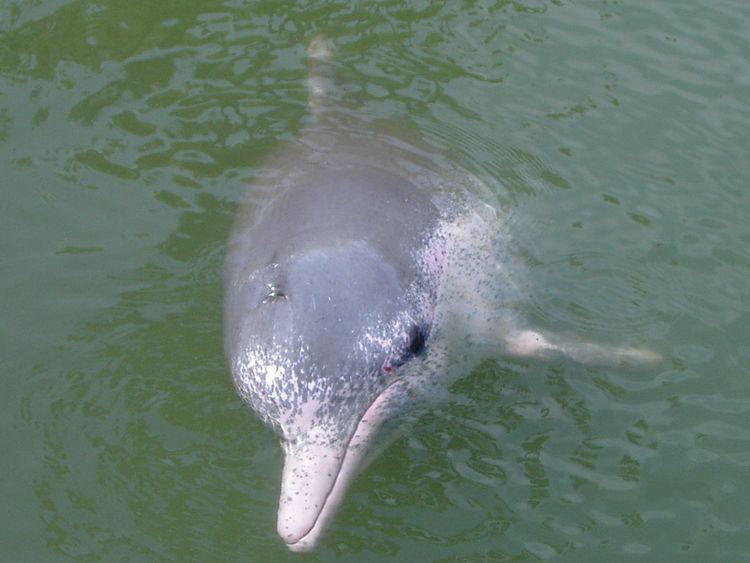Kingdom Animalia Class Mammalia Infraorder Cetacea | Phylum Chordata Order Artiodactyla Family Delphinidae | |
 | ||
The Indo-Pacific humpbacked dolphin (Sousa chinensis) is a species of humpback dolphin that is found in coastal waters ranging from southern Africa in the west to northern Australia and southeast Asia to the east. The Indo-Pacific humpback dolphin is regarded as near threatened by the International Union for Conservation of Nature (IUCN).
Contents
Range and habitat
There are two varieties, regarded by some biologists as separate subspecies:
However, DNA testing has indicated that the Chinensis-type dolphins from Southeast Asia are more closely related to the Plumbea-type dolphins than they are to the Chinensis-type dolphins from Australia.
The Indo-Pacific humpbacked dolphin is a coastal species, generally staying within a few miles of the shore and preferring water less than 20 metres (66 ft) deep. Sometimes it enter rivers, but usually does not swim far upstream.
Description
The Indo-Pacific humpbacked dolphin is a medium-sized dolphin that ranges in length from 2 to 2.8 metres (6.6 to 9.2 ft) and in weight from 150 to 200 kilograms (330 to 440 lb). Plumbea-type dolphins have a fatty hump on the back, while Chinensis-type dolphins have a more prominent dorsal fin, but no hump.
Different varieties have different coloration, although young dolphins are generally gray, with darker gray above than below. Plumbea-type adults are generally dark gray. Chinensis-type adults from Australia are generally light gray above and lighter, possibly with some spotting, below, and as the dolphins age the rostrum, melon and dorsal fin get lighter. Chinensis-type adults from South China are generally white with dark spots on the sides, although the white portions appear to be pink because of blood flow beneath the skin.
Indo-Pacific humpbacked dolphins can appear similar to conspecific Indo-Pacific bottlenose dolphins, but the bottlenose dolphins lack the hump of Plumbea-type humpbacked dolphins. And all humpbacked dolphins have a distinctive motion when surfacing, in that it surfaces at a 30 to 45 degree angle with the rostrum, and sometimes the full head, showing before arching its back and sometimes showing its flukes.
Life history
The Indo-Pacific humpbacked dolphin is most often found in schools of less than 10 dolphins. It eats a wide variety of fish and, in some areas, cephalopods, but it rarely eats crustaceans.
For the Hong Kong population, births mostly occur between January and August. Newborn calves are about 1 metre (3.3 ft) long. Females become sexual mature at about 10 years old.
Interactions with other cetaceans
The Indo-Pacific humpbacked dolphin coexists over much of its range with the Indo-Pacific bottlenose dolphin, which also lives in coastal areas. It has been known to associate with the Indo-Pacific bottlenose dolphin. It sometimes forms mixed schools with the Indo-Pacific bottlenose dolphin, at times the Indo-Pacific bottlenose dolphin is aggressive towards the humpbacked dolphin, and is able to dominate the humpbacked dolphin. The Indo-Pacific humpbacked dolphin has been occasionally observed associating with the snubfin dolphin and in these interactions the humpbacked dolphin tends to be the aggressor. Interactions may also occur with the long-snouted spinner dolphin and the finless porpoise.
Interactions with humans
The Indo-Pacific humpbacked dolphin has occasionally been kept in captivity. Currently, Indo-Pacific humpacked dolphins perform at Underwater World, Singapore. Dolphin watching trips to see these dolphins occur in Hong Kong and Australia.
The Indo-Pacific humpbacked dolphin is listed as near threatened by the IUCN. The Taiwan population is considered critically endangered. The Indo-Pacific humpbacked dolphin sometimes gets caught in fishing nets.
Conservation
China has launched the largest sanctuary in the world designed for this species on Taiwanese coasts. Dolphins are also protected in other areas such as Gulf of Kutch.
